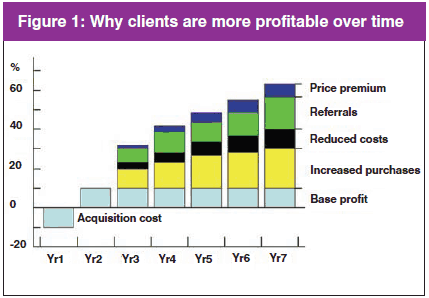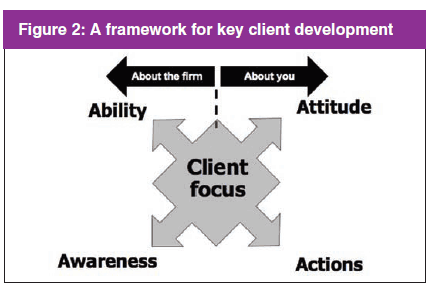 |
||
Playing the Keeps |
||
Programmes designed to support better management of a law firm’s most important clients have three distinct stages – acquiring, developing and managing. You start by acquiring the client and securing it from competitors; then move on to deepening the relationship through maximising the current business stream, broadening your services, and taking advantage of cross-selling opportunities; and then settle into the ongoing management, maintenance and relationship development of the account. Such programmes are now de rigueur for many managing partners. Few, however, can point to outstanding successes in either their development or implementation. Why is this so, and how should firms ensure that the significant investment they make delivers results? The answer, I believe, lies in the way in which firms embed a key client philosophy across their business. Why Key Clients Matter
Implementing a key client strategy represents a shift in emphasis away from a singular focus on the acquisition of new clients, and towards a more balanced approach, with proper weight placed on the firm’s existing clients. This shift has far-reaching implications for, among other things, how the firm prioritises its investments, measures and rewards its people, and goes about its business development.
Each of these is considered in more detail below. ProfitabilityThe evidence is strong that, with effective relationship management systems in place, the profitability of any client relationship increases over time. The sources of this increase in annual profit are illustrated in Figure 1.
You may not have the evidence to hand in your own firm, as it is still relatively unusual for law firm accounting systems and procedures to track profitability on a client-by-client basis, but it should be intuitively apparent that the acquisition costs of a new client will have an impact on the profitability of that relationship in the first year.
Acquisition Costs
With the cost of winning a new client many times that of retaining an existing one, the logic of investing in effective relationship management strategies, systems, processes and behaviours is
self-evident. In a law firm, the key non-monetary resource is partner time – for most partners, a focus on current clients will reap greater rewards.
Client Replacement
The corporate which is a serial purchaser of a large range of services and which has a significant legal budget is the client sine qua non of any commercial law firm. Since they know their own importance, such clients will strike a hard bargain with their lawyers. The challenge for a firm lies in shaping its client management and service model to make money at these fee levels. However, this will still generally be a better outcome for the firm than the alternative scenario, of losing its entire book of business and having to replace it – an increasingly difficult task given the troubled economy, heightened competitive forces and the increased sophistication of purchasers. There just simply aren’t many big serial purchasers about!
Why Size Doesn’t Matter
Hopefully, all this has helped to convince you that there is benefit in retaining key clients. But I know that a number of firms will still feel that they aren’t big enough to warrant a key client programme.
Which Clients You Should SelectThere are two main types of clients who will be your priority when making your selection for your key client programme:
As I mentioned above, the nature of a high value repeat client means that they are in short supply, so it is imperative for your programme to include, at least initially, strategies to “lock in” such existing clients. Any current profitability issues around these clients should also be addressed by the programme.
Why Programmes FailThere are many reasons why key client programmes fail. The three that are most commonly encountered – implementing generic solutions without understanding their application; including too many clients in the programme; and not committing to the programme in the long term – are summarised below. Generic Solutions
Many firms have implemented a generic programme without considering their own strategic context and stage of development. This is akin to putting new tyres on car, but leaving the same engine in place, and somehow expecting performance to improve markedly. Unsurprisingly, many such initiatives have failed to deliver against expectations, and subsequently cast a long, dark shadow over the whole concept.
Too Many Clients
A second common error is the seemingly irresistible urge to include large numbers of clients in the programme. Properly executed, a key client initiative use significant resources and, in particular, the time of a select group of partners. If too many clients are included, though, that small group of partners will be engaged with a large group of major clients – consequently, the calls on their time will be multiplied to unsustainable levels.
Short-TermismFinally, a programme may fail because, although the senior management team of the firm says that programme is important and must be underpinned by changes to the way in which performance is measured and rewarded, they don’t reflect this in what they do. This can leave a programme foundering, and all the time, investment and effort the firm put in will amount to nothing. How To Put It Into Practice
A strategic framework is essential in order to make sure that the fundamentals which support the key client initiative are put in place, including changes to existing processes and practices. Such an approach is not a quick fix – those firms which have implemented effective key client strategies report lead times of over 18 months before significant returns are seen. It will often take more than two years before a programme can be truly considered embedded, and part of the fabric of ‘how we do business around here’.
The model starts with ‘Awareness’, then moves clockwise through ‘Ability’ and then ‘Attitude’, finishing up with ‘Actions’. The positioning of the quadrants is significant in demonstrating the division between the first two areas, in which busy partners should expect direct support, and the latter two, which require them to change behaviours, address cultural norms and demonstrate tenacity. For the first two, the actions of the firm will have primacy, whereas for the latter two, it will be the collective actions of the firm’s lawyers which will be the principal determinant of success.
AwarenessThe awareness quadrant is concerned with research, knowledge and understanding. It provides the platform for the remainder of the client programme, since, without these foundations, any strategy runs the risk of deploying resources ineffectively or not taking proper account of opportunities and threats. This awareness should be both internal (what we have done, what we are doing, what we could do) and external (where the client is going, where the opportunities are, what the competition is up to). Ability
Having awareness is one thing, but being able to use it effectively lies at the crux of client strategy. In the ability quadrant lie analytical, interpersonal and operational skills.
Attitude
Behavioural and attitudinal change is difficult, yet it lies at the heart of making effective progress. The firm’s leadership and management team must find ways of breaking down personal ‘ownership’ of clients and undue protectionism. They need to recognise and reward those who share, while diminishing the power and influence of those who demonstrate destructive behaviours.
Actions
‘Running out of steam’ is the ultimate cause of failure for many. An initiative may be launched with a fanfare and an initial rush of enthusiasm; the result may be high expectations within the firm that the goals of that initiative are within easy and imminent reach but unfortunately, this is very rarely the case.
What Other Benefits It Brings
The principles underlying the creation of a key client strategy can be applied widely across the firm. The approach could also be used, for example, to manage key intermediaries and multipliers, from whom the firm acquires client business.
|
||
Andrew Hedley |

